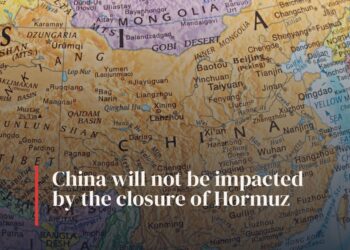How does the current Middle East Situation play out?
- The U.S. has moved large quantities of strategic assets into Europe to be within striking distance. There have been refueling, cargo, and other military assets moving within striking distance to the region over the last several days. This will enable rapid deployment into the region to support what comes next.
- The U.S. 5th Fleet has officially left its home port in Bahrain with support vessels also leaving Qatar.

- British Naval assets in the same ports have also gone back out to sea.
- The rumors are that they will launch a strike on Iran if they attempt to attack U.S. bases and military assets in the region.
- So far, the attacks have been rockets from proxies, instead of ballistic missiles from Iran. If Iran launched, it would be seen as an escalation that would result in direct U.S. involvement.
- Right now, the U.S. is providing support and “defense” to Israel but has avoided direct offensive strikes.
- Israel will continue to cripple Iran’s ability to wage war and embolden the Regime opposition to take over.
- The “King-in-Exile” resides in California, and his people—both in exile and in the country—are waiting to set up either a democracy or a democratic monarchy.
- The IRGC fights for the highest bidder, and there are already widespread reports of desertion, with ultimatums being put out for anyone not showing up for their duty.
- Several high-value targets within Iran can’t be impacted with current Israeli arsenal, but would require either a covert operation on the ground or U.S.-level “Bunker Buster” capacity. We don’t let everyone get access to the best of our toys!
- Israel isn’t done with Gaza, and once the threat is eliminated, they will give the keys to the GCC. Israel will stay as the military as the GCC sets up a government and path forward.
- The coast will play a pivotal role in the development of non-oil related trade (with the U.S., India, Southeast Asia, and Japan playing critical roles). The addition of a friendly port to the West is accretive for everyone.
It’s important to appreciate that an ideology doesn’t die overnight (or maybe never truly goes away), but it can fade. People search for an ideology to find purpose and fill a hole that may exist in their lives. If you have a job, family, and general purpose, a person is less likely to search for a “reason” to exist. This is something that happens with any “cult” type structure that offers false promises and hope.
If you look at the Middle East, the phoenix from the ashes won’t be because of Israel or the U.S. or other Allies, but by the generational shift on the ground. People are tired of the constant war, fear, and death. Are the Allies going to help, aid, and embolden the local populace? Absolutely! But change is always driven by a nation’s people because they need to WANT change. They need to want freedom and be willing to fight and establish a “new normal.” It starts as a whimper but gains steam over time until a tidal wave of change is unavoidable. There were always signs given the Iranian chants and many Iranians’ unwillingness to trample the flags of Isreal and the U.S.—but most importantly, the Iranian people’s willingness to feed so much intelligence to the “enemy.” Given the level of sensitive/ top secret information leaking out of Iran, there’s a desire for change at the HIGHEST level. It’s unlikely to be coming from the Quds Force given how blindsided Israel was by Gaza, and they would likely have that information. It also could have been dismissed as “not credible” by the Israelis, but I would wager the Mossad agent is in a different branch.
Israel will avoid impacting Iran’s exporting capacity to enable the next government to capitalize on their infrastructure. It doesn’t mean that Israel won’t take out tank farms or domestic-facing natural gas and/or refining—but they will limit the impacts to items that can be repaired quickly, without creating a terminal failure. By only hitting strategically military or government entities, it makes it clear to the populace that they are NOT the target of this campaign. As much care as possible has been made by Israel to avoid collateral damage, while Iran sends missiles directly into populated areas.
Iran will threaten the closure of the Hormuz Strait, but it’s important to look at physical capabilities versus commentary. Their ability to utilize satellites, advanced radar, and critical infrastructure (among other things), has been severely limited, if not completely eliminated, in certain districts. The U.S. has the ability to bring in specific commandos (Delta and Seals) to aid Israel, especially because they practice jointly in Israel, U.S., Jordan, and Europe for all kinds of scenarios.
There are people calling for World War 3 or some semblance of escalation, but I believe this is the closest we’ve been to long-term peace in the region over the last 40 years. I made the call that by 2030 the Iran Regime would fall, and I would be doing business there by 2035. This only accelerates that timeline considerably, and it doesn’t derail that in the slightest. Persia was a friend to the West and India for thousands of years, and it was always going to revert back to that standpoint. Geopolitics are measured in hundreds, if not thousands, of years, with deep seated distrust and relationships unlikely to waiver over the long term. We will revert back to historical patterns with Iran (Persia) aligned with India and Israel, as the GCC and new Shia government find a path forward. I was always concerned about which path the Hanbali and Wahhabi Sunnis in Saudi Arabia would take, but they’ve been moving closer to the path of the West and UAE. All of these shifts will have growing pains and pitfalls, but we are moving in a direction that will usher in a new period of growth, investment, and prosperity in the region.
How does this impact crude?
I would avoid crude altogether, but if you want to dip your toe into the chaos, lean short. There hasn’t been any impact on export abilities or production. The gas facility that was hit is purely an import vehicle for domestic consumption. The tank farms that have been struck purely serve the domestic market.
What is the best play?
Buy diesel! There is already a broad shortfall in the market, and the elevated crude price (which will take time to fade) will make the diesel crack very rich for many refiners. There is also going to be more MGO (marine gasoil) and bunker fuel burned to avoid these key regions.
Does Iran have nuclear capabilities?
No, but they do have hyper-sonic re-entry capacity. This makes it difficult for the current Arrow, THAAD, and Patriot missiles to intercept unless it’s outside Earth’s atmosphere prior to re-entry. Our systems are doing very well in real time with a very low success rate of Iranian impacts, but it’s a game of attrition when it comes to the next wave of attacks. Israel is trying to knock out as many launchers as possible prior to nightfall.
How quickly could a regime change take place?
This is a difficult question to answer. While a large part of the populace wants change, there are still hardliners that will fight. The big shift will be in how the military reacts (outside the IRGC). They have not followed direct orders against protestors in recent years.
What are the broader implications to the geopolitical world?
These attacks demonstrate how much influence and prestige Russia has lost around the world. Their equipment has been shown to be completely ineffective against current available substitutes: S-400 (Russia’s most advanced system) vs. F-35 & compared with THAAD, Arrow, and Patriot Batteries, Russian designed telecommunications for aircraft failed, and they’ve been unable to service existing contracts. For example, Russia signed an agreement to deliver 50 Su-35 fighter jets to Iran since 2021. The deal was modified in 2022 where Iran gave Russia 1.700 Shahed drones in exchange for 24 of the aircraft. Russia took delivery of the drones but never honored their side of the agreement. Russia’s tactics and miscalculations are vast, with the biggest one being the drive to take Kiev. This will fall under one of the biggest military blunders since Hitler pushed into the USSR in 1943. Russia has had to pull assets from Venezuela, Iran, Syria, and Central Africa—each with their own layers of defeat.
India has quickly moved further into the sphere of influence with the U.S. and Middle East, especially after Houthis targeted Indian naval assets. Their inherent distrust of China and long-standing relationship with Iran (Persia) have them quickly moving back to the “Old Silk Road.” This will help box out Chinese expansion and provide a solid trade route and economic growth for the region. India paused all purchases of Iranian crude once the Houthis fired on the Indian Navy and flagged merchant vessels. (This is important because India has built refiners specifically for Iranian crude, to give you an idea of how aligned they’ve been in the past.) India also experienced the ineffectiveness of Russian aircraft in their recent skirmish with Pakistan. There were multiple communication failures reported, which is common across their various aircrafts. India has canceled their orders for additional Russian aircraft and S-400 systems, while shifting those purchases to U.S. manufacturing.
China has relied heavily on Iran and Russia for a significant number of raw materials, oil & gas, and military capacity. While watching their performance in real time, there is likely a hesitance regarding the operations of anti-missile/ anti-aircraft, as well as the base of telecoms used in their aircraft.
What other impacts are there?
At C6 Infrastructure Partners, we’ve been focusing on the fertilizer world, as well as power and energy. The knock-on effect of this ongoing conflict is urea production and availability. Iran has struck a refiner and gas processing asset in Israel, but they had pre-emptively shut operations prior to the attack. When we look at that region, about 40% of global urea exports is at risk. Iran has shut all seven of its ammonia-urea facilities, and Egypt halted operations since Israel shut gas production. Egypt gets a large part of their natural gas from Israel for these facilities.
I’m by no means saying that Iran’s regime changes tomorrow, but the shift in generation dynamics has been palatable for years, and this is a pivotal moment for broader change in the region. Change will not come in a straight line, but the mission critical push has alignment from the West, GCC, and Israel.
In the two decades that I have been writing and speaking about geopolitics, Iran (the Middle East, in general) has been a focal point, given the amount of attention they draw. They support a significant amount of terrorism activity in the region, and Iran once saw a very robust “Shia Crescent.” The chart shows the influence across Iraq, Yemen, Syria, and Lebanon. Iran’s fingerprint became solidified during ISIS (a Sunni Sect), which ushered Iranian military power into Iraq, Syria, and other regions. The GCC (Gulf Cooperation Council)—outside of Qatar—were very wary of the strength and expansion of Iranian influence.

Even before the fall of ISIS (territorially) in 2017, Iran was losing a significant amount of support internally. The younger generations were demanding change and a movement back to a lifestyle common in Iran prior to the 1979 Revolution. It started small but has only gained momentum over the years. In the beginning, the IRGC squashed any protest with an iron fist, resulting in deaths, brutal arrests, and torture.
President Obama signed the JCPOA in July 2015, which went into effect Jan 20, 2016. There was a belief (mine included) that this would usher in a slow shift in favor of the populace, as well as political goodwill. We saw some “reformists” make it into government, and some loosening of internal policies. The JCPOA released a significant amount of capital, and the belief was that it would funnel to the people and local infrastructure (i.e. the region had faced significant droughts over the year, and Iran hadn’t updated their irrigation systems in decades). Instead, we saw a HUGE flow of capital into terrorist cells, creating a significant increase in equipment and influence being moved into Iraq, Syria, Yemen, and Lebanon.
The shift in capital flows to our enemies was the biggest reason President Trump abandoned the JCPOA, but it also enraged many of the local populace that were experiencing over 30% unemployment—especially in the 18–30 age bracket. People saw that this capital that could infuse life into a struggling economy, repair global trade, increase industry, and build infrastructure was instead flowing to terrorists. This is where the levees of anger began to break. President Trump made sure to speak to the people—through the Swiss Embassy—that the U.S. fight was NOT with the people of Iran, but the regime.
President Trump wanted to send a message to Iran and Russia (Iran’s biggest supporter) that we know the failures of the S-200, S-300, and S-400 anti-missile and air defense. The U.S. launched 59 Tomahawk cruise missiles in April 2017 that showed the massive gaps in their defenses. The U.S. strategy showed that the systems don’t speak to each other. Missiles flying sub-mach at low altitudes could easily “trick” the systems, especially in the gaps where their coverage doesn’t “overlap.” The systems don’t speak to each other, so they have to be positioned in a “Venn Diagram” structure to avoid any gaps in protection. The U.S. THAAD, Arrow, and Patriot systems all speak to each other, enabling for a “dome-like” protection over a specific area.
This show of force created a lull in the region until Iran launched an attack against Saudi Arabia in September 2019. There were always attacks against U.S. assets in Iraq, but this created a big shift in the balance of power. Iran broke the “rule” of never attacking a GCC nation, and there had to be a shift in how Iran was handled. In January 2020, the U.S. killed Qasem Soleimani near the Baghdad International Airport. He was the leader of the IRGCs Quds Force that handled clandestine missions across the Shia crescent by providing guidance, funding, weapons, intelligence, and logistical support (among other pivotal ways to wage guerilla tactics). He successfully carried out attacks against U.S and Allied soldiers, and was the mastermind behind crushing Iranian protests. This sent a clear message to Iran that things were about to shift, and they responded by launching Ballistic Missiles at non-valuable targets to show force but avoid escalating. The shift in aggression was the first massive show of weakness by the Iranian regime. Israel also launched several assassinations against nuclear scientists within Iran, all of which were top secret entities and locations. This showed how deeply the Iranian government had been infiltrated, but it also created another level of overconfidence when it came to Gaza.
In the meantime, Israel had been gathering significant intelligence throughout the region, with a focus on Syria and Lebanon. They had slowly started to increase airstrikes against Iranian assets in Syria, but once Soleimani was killed, Israel was given the green light. They made a silent agreement with Russia that as long as their assets weren’t touched, Israel could strike IRGC assets at will. This led to countless strikes against weapon deliveries and other sorties, taking out equipment while avoiding targeting “high value” human entities. While the Mossad and Israel intelligence gathered information and set plans in place, the U.S. provided guidance on “how” to defeat S-200-400 systems in real time, showing the value of “cutting off the head of the snake,” or military decapitation. The UAE, Bahrain, and Morocco also normalized relations with Israel on August 13, 2020 as part of the Abraham Accords. They were the first GCC nation to create a formal shift with other smaller ones, coming from Oman following the Israel-Jordan peace treaty in 1994. Egypt signed a treaty in 1979, but their relations significantly improved when the Israeli military worked with Egypt to secure the Sinai Peninsula and structured a long-term gas agreement.
President Trump lost re-election, which ushered in the Biden presidency. While President Biden spoke about bringing the JCOPA back, he maintained many of the same policies put in place by Trump. But he wasn’t willing to play international games, creating uncertainty about his actions. President Trump was willing to say one thing but do another, regardless of what Allies or the U.N. thought. This kept our enemies guessing. Biden followed the path of Obama, which created an opening for the launch of very planned, coordinated attacks.
Israel continued to launch attacks in Syria, hitting Iranian assets at will, but they’ve always had their own political issues. More and more assets were being pulled away from Gaza and deployed in the West Bank and other politically motivated areas. Israel has fought multiple battles against Hamas in Gaza, with the most intense one in 2014 when a very elaborate tunnel system was found to be beneath the walls. This was the deepest Israel had pushed into Gaza, but once the objective was deemed “achieved,” they retreated. Israel dug the walls deeper, and had believed they’d secured the border, leading to a false sense of security. The loss of manpower was replaced with technology believed to be enough to provide warnings of a “Gaza Strike.” Instead, it led to MASSIVE gaps in their defenses that were expertly utilized to launch a pre-emptive attack on Israeli “soft targets.” (A soft target is considered anything that isn’t military—such as a community, concert, mall, shops, and other areas that have no defenses.) Then came Oct 7 2023, which was quickly followed by the Houthis launching missiles into the Red Sea on Nov 19 2023. Hezbollah was slow to react given the headwinds they faced within Lebanon, as the local government and populace DO NOT support the terrorist organization. Many of their locations were neutralized quickly, and without Iranian support Hezbollah couldn’t maintain strategic positions.
The death nail for Hezbollah came with the deep infiltration of the beeper/ radios that had explosives embedded in the devices. After more than a decade operation, the communication system for Hezbollah and their supporters were rigged to blow. The organization pushed out all of the new equipment to coordinate attacks against Israel. Just as some of the senior entities became suspicious, Israel sent the deadly code that caused all of the equipment to overheat and explode on a delayed reaction. This was designed to blind, maim, or kill whoever held the devices, while minimizing collateral damage. They followed this up with several strategic assassinations. The final coordinated attack came during one of the senior leader’s funerals. Israel continued to take out anyone in the upper level of control, or any person appointed as their replacement. Hezbollah has formally announced that they won’t support Iran in their fight against Israel.
Iran was found to be behind the successful attacks in Gaza, as well as coordinating with other entities throughout Yemen and Lebanon. They hoped this might derail the normalizing of relationships between Saudi Arabia and the rest of the GCC with Israel. Instead, it caused a broad panic that Iranian Shias were able to get a Sunni sect to go along with their plans. Israel has been freely operating in Iraq, Jordan, and Saudi Arabia airspace, with Jordan and KSA actually joining in to shoot down drones and ballistic missiles sent since the broader conflict began last year.
There have been several “tit-for-tat” attacks, but as the U.S. was unwilling to change the rules of engagement in the Red Sea, Israel launched a long-range, coordinated sortie against assets in Yemen in September 2024. This was the farthest Israel’s Airforce had traveled to deploy their sorties, and it was a testing ground for a much bigger plan of operation. Israel carried out successful assassinations of Hamas leaders within Tehran that led to the first volley of ballistic missiles aimed at Israel. As the Houthis continued to attack with missiles and drones, there were enough successful strikes that Israel deemed an attack was justified on Iran. In Oct 2024, Israel launched a campaign to destroy all of Iran’s advanced warning and missile/aircraft defense systems consisting of the S-200, 300, and 400. Given the issues Russia is facing with Ukraine, Russia canceled all replacements and new equipment being sent to Iran. This made them vulnerable for the next layer of action that would come to pass.
Upon winning his second term, President Trump gave Iran a 60-day ultimatum to re-enter a nuclear agreement with the U.S. In the meantime, Israel had stabilized their northern front with Lebanon and was holding steady in Gaza. As the deadline approached, Mossad and Israeli special forces infiltrated the Iranian border to establish local drone facilities that would be used to take out near- and medium-proximity anti-aircraft/missiles, as well as any ballistic missile systems located. As the end of the 60-day window approached, the U.S. and Iran were set to speak on June 16. Instead, Israel received the green-light to proceed how they saw fit. Israel launched a hover 200 aircraft to fly into Iranian airspace to strike high-value targets. An hour before their presence would be known, the suicide drones were launched, crippling all of the remaining air-defense systems, as well as any missiles that could strike quickly. They also assassinated many senior officers and nuclear scientists to create confusion and cripple the military. This created utter chaos within the military ranks and resulted in many delayed reactions and strategic failures.
Iran has launched several waves of ballistic missiles into Israel, just over a dozen have landed successfully, while the rest have been destroyed in the air. Israel has taken control of the airspace and now has complete air superiority, with the remnants of Iran’s Airforce decimated (both in equipment and senior personnel). Iran is a big country, and there will be remaining missiles available to strike Israel. But sorties have successfully targeted ballistic fuel depots, as well as assembly, manufacturing, and storage locations. This will shrink the available assets that can be used to counter continuous bombardment from Israel. On the ground, there continues to be Mossad and Israeli special forces operating within Iran, carrying out assassinations of high-level targets and strategic military and industrial assets. Iran has canceled all current and future delivery of drones to Russia, and the Kremlin has “officially” rejected Iran’s request for military aid. Remember, Russia rapidly pulled out of Syria, resulting in the quick fall of Al-Assad.
It’s important to understand that regime changes don’t come easily, and a true shift in power can only be done by the local populace. Without a full ground invasion and occupation, Israel and their allies can only pave the way for a shift utilizing air and strategic missile attacks. The Israeli leadership has been very clear to the populace that their fight is against the regime and NOT the people of Iran. Israel and Iran (Persia) were once great allies throughout history, with both being pivotal in the Silk Road. President Trump and Modi held a lengthy press conference discussing the establishment of the “New Silk Road,” or India-UAE-Israel Economic Corrido. I do find it funny that they talk about “establishing” the trade routes, which have been in existence for thousands of years. The GCC is pivotal for the shift, and while KSA said they condemn Israeli action, they were also more than happy to let them use their airspace. The most important thing to remember is: We can’t look at the political words (usually spoken to save face) but have to look at the actions taken around them strategically and militarily. Actions are the greatest predictors of intent and the best indicators of how these situations may play out.













